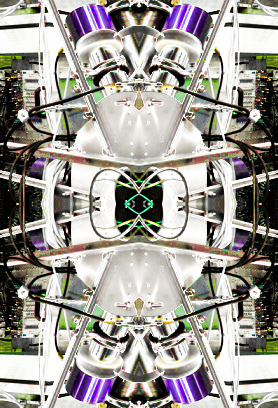Physicists circle fifth force
 Scientists have seen tiny hints of a possible fifth force of nature.
Scientists have seen tiny hints of a possible fifth force of nature.
As far as we know, our universe and everything in it is defined by gravity, electromagnetism and the strong and weak nuclear forces – known as the four fundamental forces in the standard model of physics.
But as physicists begin to test the very outer limits of the standard model, gaps are appearing. One of these unknown areas contains the idea of dark matter - an invisible substance that appears to make up more than 80 per cent of the Universe’s mass.
There are a lot of ideas, including one that says “dark photons” could carry the dark forces in the same way that regular photons carry electromagnetic forces, but there is almost no evidence for any of the explanations.
Now, a team from the Hungarian Academy of Sciences’ Institute for Nuclear Research hat was searching for evidence of dark photons may have found something similar, but very different.
The Hungarian team used an electron-positron spectrometer to fire protons at thin targets of lithium-7. This created unstable beryllium-8 nuclei that spat out pairs of electrons and positrons as they decayed.
Normally, physicists would expect that the number of observed pairs decreases as the angle between the trajectory of the electron and positron increases.
But this time, at an angle of about 140º, the number of emitted pairs jumped.
This created a ‘bump’ in the number of pairs plotted against the angle, before it began dropping off again at higher angles.
It was just a bump, but it could mean something huge.
Research leader Attila Krasznahorkay says the bump strongly indicates that a little bit of the unstable beryllium-8 nuclei shed excess energy in the form of a new particle.
Krasznahorkay and colleagues calculated the new particle’s mass to be about 17 megaelectronvolts (MeV).
Over the last three years, the team has repeated its experiment time and again, eliminating every conceivable source of error and seeing the same bump every time.
They say that now, the odds of seeing such a significant anomaly appear randomly are about 1 in 200 billion.
“We are very confident about our experimental results,” Krasznahorkay says.
They propose that the particle is not a dark photon, but in fact a “protophobic X boson”.
Such a particle would carry a force that acts over the most miniscule distances – just a few times the width of an atomic nucleus. In technical terms, where a dark photon would theoretically couple to electrons and protons, a protophobic x boson would couple to electrons and neutrons.
The Hungarian work first appeared on the pre-publication research site arXiv.org in January, but it was not until a group of US theoretical physicists posted their own analysis of the result that people really started talking.
The US theorists found no conflict between the Hungarian data and any previous experiments or models.
They concluded that it is the best evidence yet for a fifth fundamental force, and that the protophobic x boson idea is “the most straightforward possibility”, according to US physicist Jonathan Feng.
But this is science, where no one believes anything, so already groups around the world are rushing to repeat the finding and find different ways to check it.
The science community may not have to wait long to find out if the 17-MeV particle really does exist.
MIT’s DarkLight experiment will fire up soon, specifically aimed at searching for dark photons with masses of 10–100 MeV. A spokesperson for the project says it will now target the 17-MeV region as a priority. They expect to be able to either find the proposed particle or at least narrow it down within a year.
The Large Hadron Collider at the CERN near Geneva is on the hunt too, as is the Budker Institute of Nuclear Physics in Siberia and the INFN Frascati National Laboratory near Rome when it is switched on in 2018.
Speaking to the journal Nature, theoretical physicist Rouven Essig says the “somewhat unexpected” properties of the proposed boson make a confirmation unlikely, but that doesn’t mean scientists shouldn’t try.
“It would be crazy not to do another experiment to check this result,” he said.
“Nature has surprised us before.”








 Print
Print